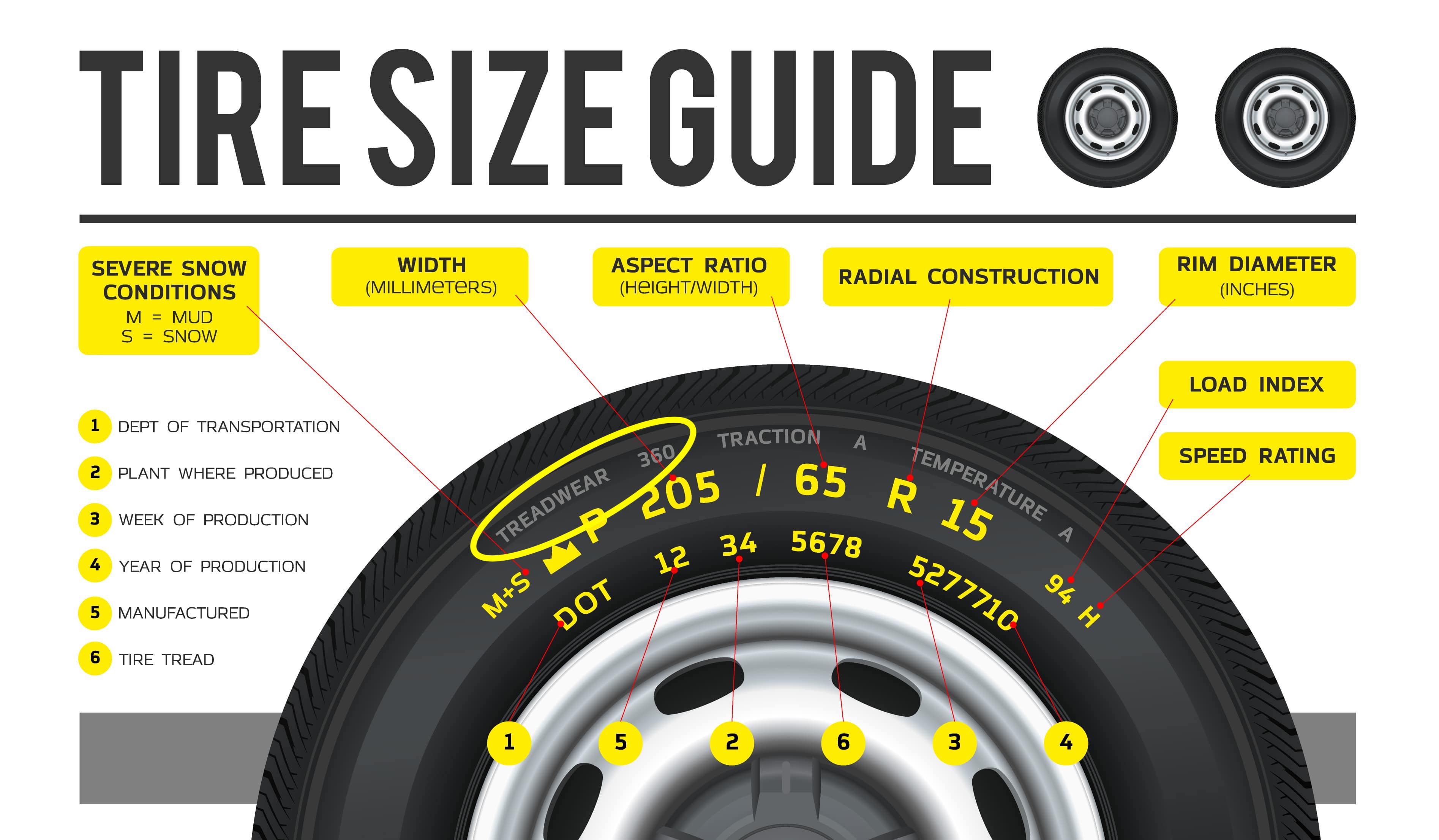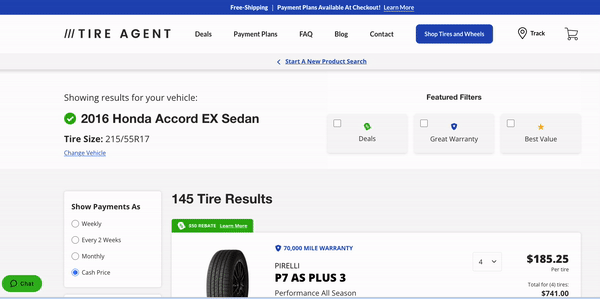Your Shopping Cart
Your cart is empty.
Subtotal ( items)
Instant Rebate Applied:
Promo Code Applied: ID.me Discount Applied:
Have a Promo Code?
Size:
Item
Item
Selected for:
/ each
Add-Ons
Wireless air pump capable of pumping up to 150 psi with 2000 MAH power bank.



Fully protect your clothes and vehicle interior during transportation of your tires. For Tires up to 31" tall and wheels up to 22".
Per sensor
Add TPMS Sensors
/per sensor
Please confirm the make, year, model and trim of the vehicle you want to purchase for:
How many sensors do you need?
The vehicle you have selected is not compatible with aftermarket TPMS Sensors.
Enter a different vehicle to add TPMS sensors

 Front Tire Size:
Front Tire Size:
 Rear Tire Size:
Rear Tire Size:
 Your Vehicle:
Your Vehicle:
Pros & Cons of Staggered Fitment

Attractive Design

Improved Handling

Improved Cornering
Bumpier Ride
Poor Traction in Snow
How do I find my tire size?



Need help?
 Your Vehicle:
Your Vehicle:
Pros & Cons of Staggered Fitment

Attractive Design

Improved Handling

Improved Cornering
Bumpier Ride
Poor Traction in Snow
How do I find my tire size?



Need help?
Pros & Cons of Staggered Fitment

Attractive Design

Improved Handling

Improved Cornering
Bumpier Ride
Poor Traction in Snow
Need help?
Need help?
How do I know if I have an LT tire?

 Your Vehicle:
Your Vehicle:
Sorry, we could not find any available
wheels for your sizing selections.
Need help?
Tire Speed Rating Guide
By Tire Agent Staff
October 17, 2023
This guide does a deep dive into tire speed ratings, to further explain the numbers on the side of your tires. We answer common questions: What does speed rating mean on a tire? How do you know what the speed rating is for your vehicle? What is the most common speed rating for a passenger tire?
First, let's explain what speed rating means in tire talk: A tire's speed rating refers to the fastest speed the tire is designed to go for a prolonged period of time under normal driving conditions. The speed rating signifies its maximum safe operating speed, under typical driving conditions. If you see tires with an H rating of 130 MPH, it's not safe to drive faster than 130 MPH.
Let's be clear: Unless you're a professionally trained driver on a racetrack or a law enforcement officer, and you're wearing protective gear, 130 MPH is never a safe speed.
Tire Speed Rating Chart
Below is the index of the various speed ratings, from L to Z. So, for example, a Q speed index on a tire means it's a winter tire intended for 4x4 use. Similarly, a Z-rated tire is intended for a high performance sports car.
Why do we start our chart at letter L? Anything rated lower than that is not intended for passenger or commercial vehicles and may not be safe or legal for driving on open roads.
| MAXIMUM SPEED (MPH) | VEHICLE TYPE | |
| L speed rating | 75 | Off-road, light truck |
| M speed rating | 81 | N/A, temporary spare |
| N speed rating | 87 | N/A, temporary spare |
| Q speed rating | 99 | Winter 4x4 |
| R speed rating | 106 | Heavy-duty light truck |
| S speed rating | 112 | Family sedan, van |
| T speed rating | 118 | Family sedan, van |
| U speed rating | 124 | Sedans, coupes |
| H speed rating | 130 | Sport sedans, coupes |
| V speed rating | 149 | Sports cars |
| Z speed rating | 149+ | Sports cars |
| W speed rating | 168 | Exotic sports cars |
| Y speed rating | 186 | Exotic sports cars |
| (Y) speed rating | 186+ | Exotic sports cars |
You might wonder why tire speed rating H is out of order, situated between U and V? Before 1991, according to a Wikipedia entry about tire codes, the letter H stood for "high performance," with a speed rating of 130 miles per hour. Because H has been one of the most popular speed ratings, the powers that be left the speed rating H at 130 MPH.
Why does tire speed rating matter?
Speed ratings aren't only about speed, despite their name. Speed rating considers how the tire was constructed. Speed ratings represent ride quality, wear, and cornering ability.
A tire's speed rating affects vehicle handling. How? Tires with higher speed ratings are typically designed to offer better gripping and stopping power, resulting in improved handling and performance in various driving conditions.
A higher speed rating means better gripping and stopping power. Unfortunately, this can also mean shorter tread life.
The other warning to consider with tire speed is the age of the tire. The tire maker Lionhart explained it best: Speed ratings are based on tire manufacturers' laboratory tests, which can’t account for every possible condition that a tire might encounter on the road. A tire’s speed rating may not be accurate if the tire is:
- Underinflated
- Damaged
- Overloaded
- Used in extreme weather conditions
- Driven on for long periods of time at high speeds
- Old or near end of life
What else does tire speed rating affect?
The speed rating of a tire is all about handling and performance, but it can also impact ride quality, tread wear, and cornering, especially for high-performance sports cars. Tires with higher speed ratings (V, W, Y, Z) tend to provide better grip and stopping power; however, they tend to have a shorter tread.
Should tires match the OE speed rating?
Yes and no. Tires should always at least match but could also exceed the original equipment (OE) tire's speed rating. The reason? You want to maintain the vehicle's original performance, handling characteristics and fuel efficiency. Using tires with lower speed ratings could negatively affect the vehicle's handling and overall driving experience.
How is a tire's speed rating determined?
Manufacturers self-evaluate and test their tires to give them their own ratings. They use a variety of factors, including the materials they use to construct it, the tread tire design, and construction techniques.
Can you buy replacement tires with different tire speed ratings?
Remember that you can always increase the speed rating of your vehicle's tires for better performance, but you can never lower it without lowering the vehicle's top speed to the reduced speed rating. Read more about mismatching tires.
What about trailer tire speed ratings?
A complete tire speed rating chart actually begins with the letter A, which translates to tires that are designed to go no faster than 3 mph. Obviously, not many vehicles, even bicycles, are that slow. Tire speed ratings of B through K (except H) are not intended for passenger vehicles. B-rated tires have a maximum speed rating of 31 MPH and K has a maximum 68 MPH; these speed ratings may be more common on farm and construction equipment.
You might be wondering what the correct speed rating is for trailer tires. You generally want to keep trailer speeds between 55 and 75 MPH. Tire ratings for trailers are G, J, K, or L.
Common Speed Ratings
When you look at a speed rating chart, you'll notice ratings are represented by letters.
- Most common speed rating for passenger vehicles: H
- Most common speed ratings for sedans: H, S and T
- Most common speed rating for minivans and SUVs: S and T
- Most common speed rating for sports cars and coups: H
- Most common speed ratings for light trucks and truck tires: H, N, P, Q, R, S and T
- Most common speed ratings for high-performance vehicles and EVs: V, W and Y
- Most common speed ratings for winter tires: Q, S and T
Each letter has a corresponding speed rating approved by the DOT (U.S. Department of Transportation) and the tire manufacturer. The most common speed ratings range from L (75 MPH) to W (168 MPH).
Exotic sports cars typically have a speed rating of 184 MPH, represented by Y.
Difference between H and V rated tires
One of the most common questions we get is to explain the difference between H vs V rated tires. You'll generally find H-rated tires on sports sedans and coupes. H has a maximum speed of 130 MPH. V-rated tires are typically for high-performance sports cars. V has a maximum speed of 149 MPH. At one time, V-rated tires were the highest speed-rated tires, but that has since been replaced by W, Y and Z-rated tires.
How to Read Tire Speed Rating
Where is the speed rating symbol on a tire? There are three places that you can find your vehicle's recommended tire speed rating and dimensions:
- Owner's manual
- Inside the driver's door panel
- Your existing tire's sidewall
The easiest way to find it is on the tire itself. Looking at the image above, you'll see the letter H on the tire's side. That means this tire speed rating is H.
When you shop for tires online with Tire Agent, we'll match you with the best aftermarket replacement tires that are available for your vehicle. You can use the filters to narrow your search and compare speed ratings. In this short video, we used a 2016 Honda Accord EX sedan and then narrowed our search to H-rated tires:
Source: BFGoodrich Tire Speed Rating Chart
Photo 44260996 | Car Driving Fast | Nomadsoul1 | Dreamstime.com
Next Post:
6 Best Apps for Buying and Selling CarsHow to Qualify for the $50 Offer
- Add items to your cart and begin checkout.
- Select PayPair and apply for financing.
- If you’re approved by a participating lender, you’ll see a $50 promotional rebate applied to your order total.
-
To receive the $50, you must:
- Complete your purchase with a qualifying lender,
- Agree to the payment terms,
- And make the required number of consecutive on-time payments, as specified by the lender.
Note: Offer available only through select lenders. Additional eligibility requirements and conditions apply. Rebate may be issued after verification of qualifying payment activity. Terms subject to change.
How to Purchase Tires and Wheels
With a Payment Plan
Tire Agent's payment plans make it easy to get the best partial or full set of tires and wheels for your vehicle.
It's fast, secure and won't affect your credit score
Match with multiple lenders
Why Choose PayPair?
PayPair’s Partners and Plans

No Money Down

No Money Down

No Credit Needed*

No Money Down

$1 to Start!*

No Money Down

No Credit Needed*

$1 to Start!*

No Money Down
Other Payment Plans

$0 to Little Down

Pay with your bank account

Simplified checkout experience

Faster and easier than using cards or cash

Simplified checkout experience

Faster and easier than using cards or cash
*SNAP: The advertised service is a lease-to-own agreement provided by Snap RTO LLC. Lease-to-own financing is not available to residents of Minnesota, New Jersey and Wisconsin. NO CREDIT NEEDED: Not all applicants are approved. While no credit history is required, Snap obtains information from consumer reporting agencies in connection with applications, and your score with those agencies may be affected. PAYMENT PLAN: The standard plan consists of renewable lease terms. To exercise an early ownership, consumers must make regular payments on time and schedule additional payments via the customer portal or by contacting Customer Care at 1-877-557-3769. KATAPULT: The Promotional Initial Payment (plus any applicable taxes and fees) is due at lease signing. Your lease-purchase payment amount will be determined after you select your product(s). You will not acquire ownership of the product(s) if the total amount necessary to acquire ownership is not paid. The Promotional Initial Payment does not reduce the cost of the lease-purchase agreement. The Promotional Initial Payment is only available when shopping at Tire Agent through the Katapult mobile app and at Tire Agent’s website. Product pricing subject to change and availability. Disclosure: 90-day early purchase option (EPO) terms and conditions apply: 90-Day (3 months in CA) You can buy out your lease-to-own agreement within the first 90-days. This amount includes the cash price, plus the lease-to-own cost for the first 90-days. Taking advantage of the 90-day purchase option will save you the most money! PROGRESSIVE: Ownership by rental/lease agreement with Progressive Leasing costs more than the retailer’s cash price. Select items only. Cancel or purchase early at any time. Not available in MN, NJ, VT, WI, WY. Progressive Leasing obtains information from credit bureaus. Not all applicants are approved. Standard agreement offers 12 months to ownership. 90-day purchase options cost more than the retailer’s cash price (except 3-month option in CA). To purchase early or to cancel lease, you must call 877-898-1970. Retailer cannot activate early purchase options.



